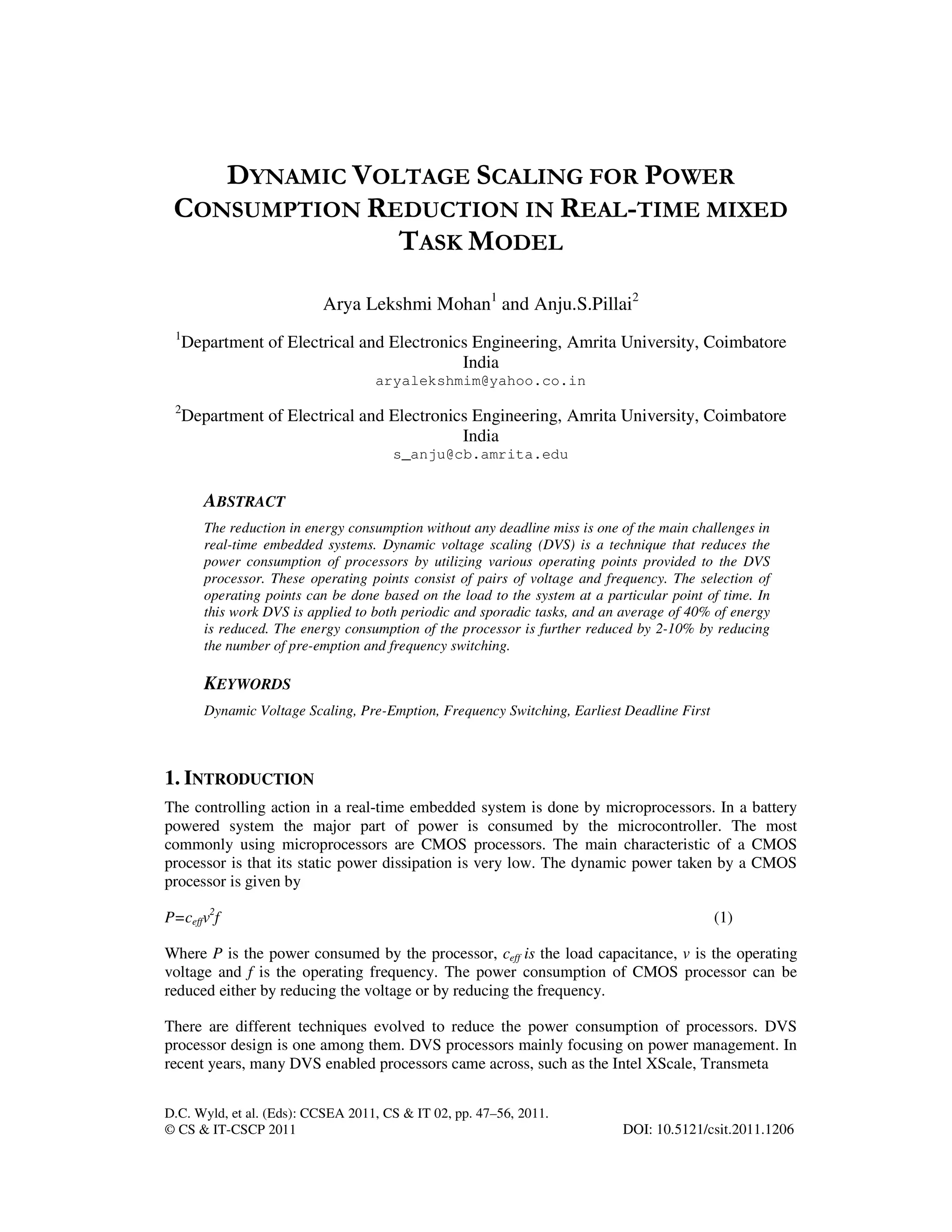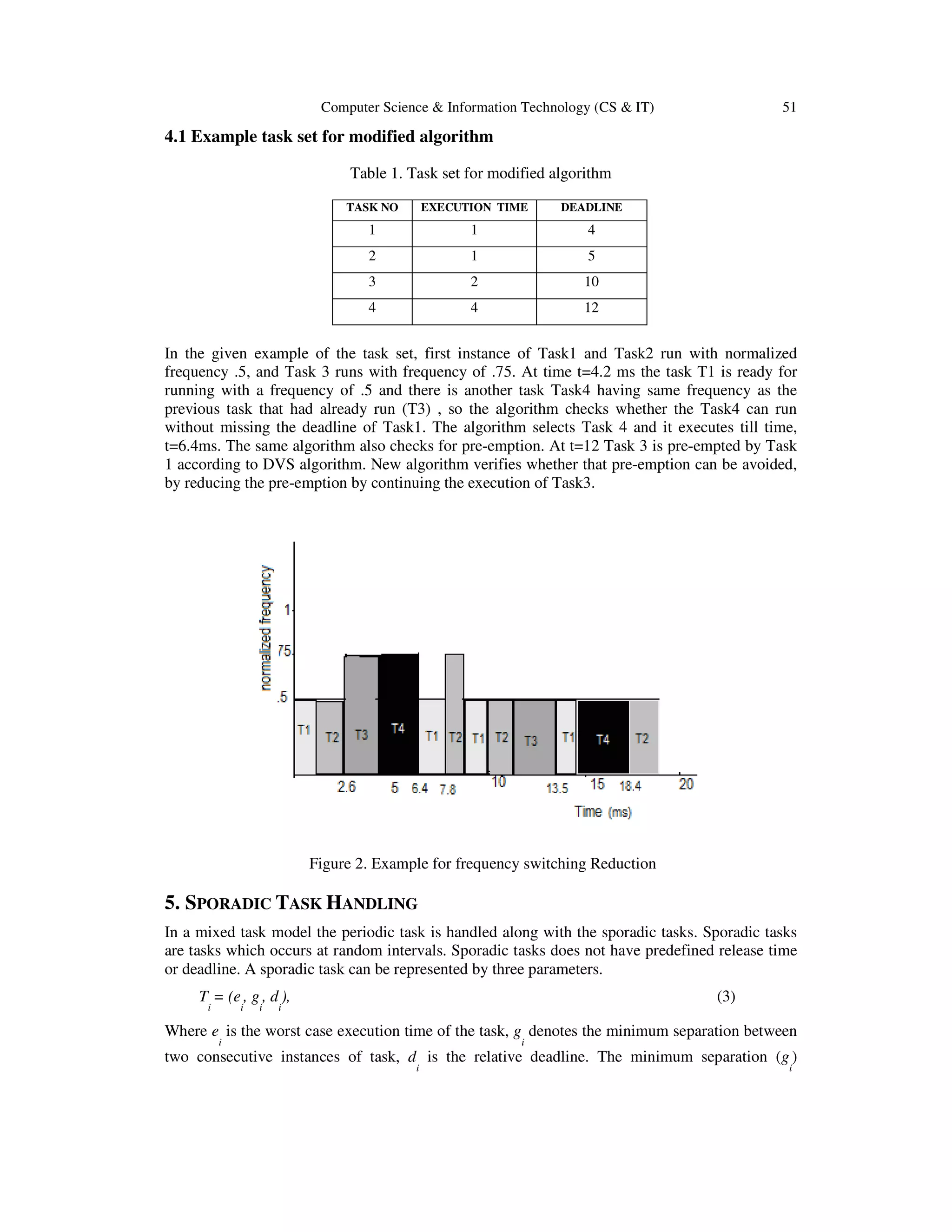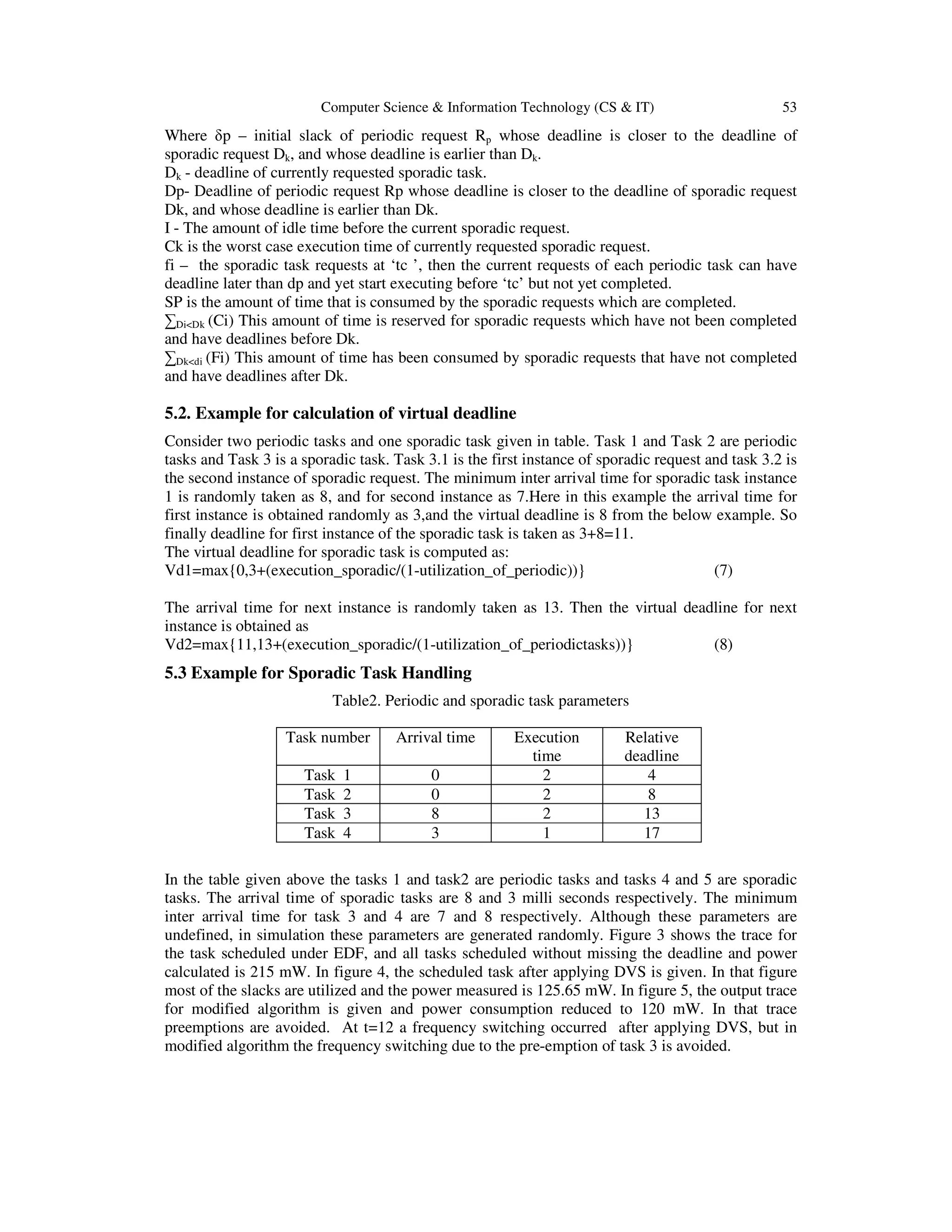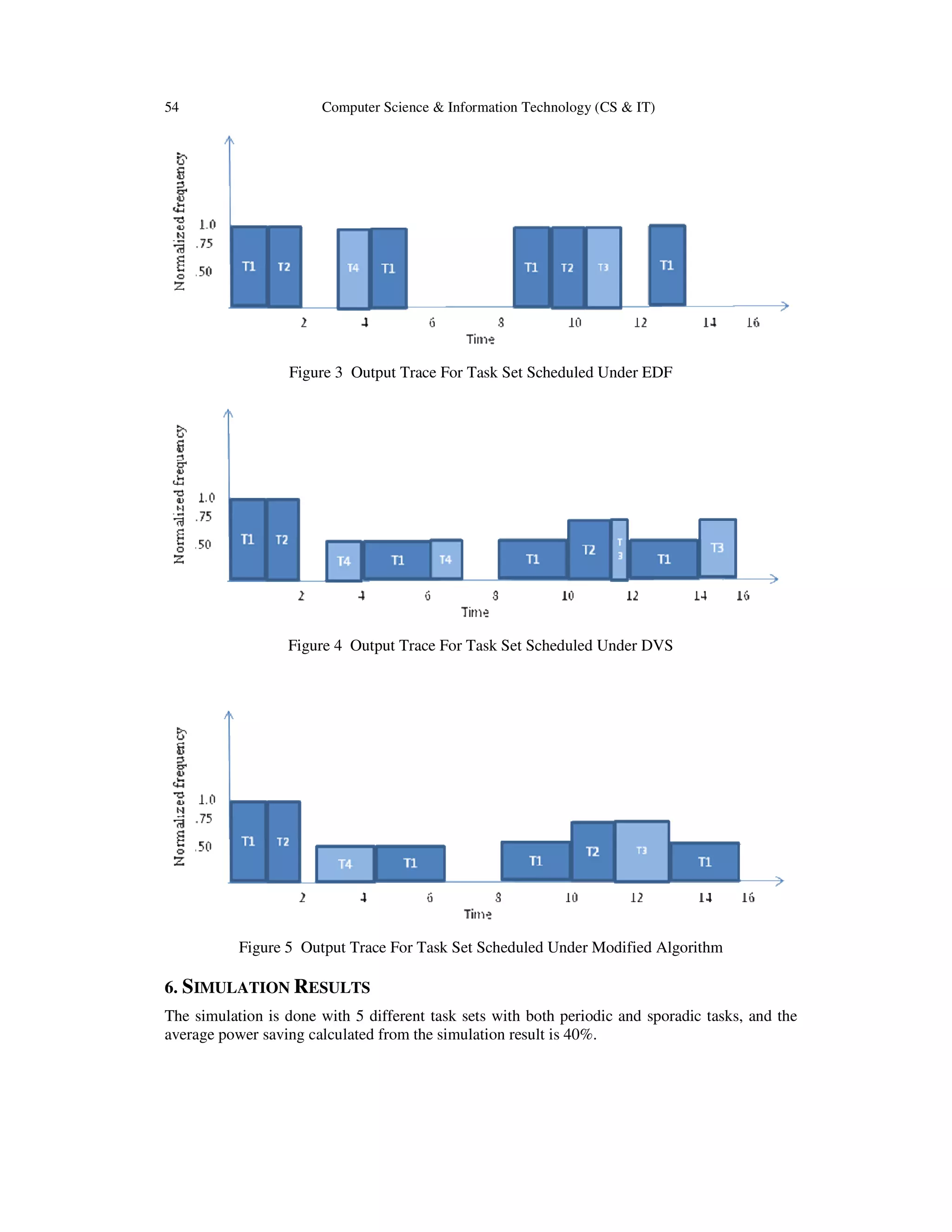This document discusses dynamic voltage scaling (DVS) as a technique to reduce power consumption in real-time embedded systems without missing deadlines. By applying DVS to both periodic and sporadic tasks, an average energy reduction of 40% is achieved, with further reductions through minimizing preemption and frequency switching. It also details various algorithms and models to effectively manage real-time tasks in conjunction with DVS for optimal performance.

![48 Computer Science & Information Technology (CS & IT)
Crusoe etc. They have discrete number of voltages and its corresponding frequency levels to
switch in between. As the number of voltage levels increased the power consumption of the
system will get decreased, in fact the tasks will get more choices to select frequency and voltage.
The problem with increase in number of voltage and frequency level is that there is a chance of
increased frequency switching.
A real-time task can be defined as a set of instructions that executes to perform a function such as
I/O, peripherals etc. The characteristics of a periodic task are release time, deadline and its
execution time, whereas the release time and deadline of a sporadic task is undefined. Release
time is the time at which a task is ready for running. Execution time is the maximum time
required for a task to complete. Deadline is the time before that particular task should complete its
work. In a realistic scenario the real-time systems have to handle a number of periodic and
sporadic tasks without crossing its deadlines. In this work we consider the system with both
sporadic and periodic tasks. For simulation, the release time of sporadic task is generated
randomly.
Dynamic voltage scaling technique has more to do with real time scenarios like wireless sensor
networks which are battery powered. In such systems the sensor node has to monitor the
environmental changes and send the information to a controlling station. In industries the sensor
node continuously monitors the environmental parameters such as temperature, pressure etc, and
sends them periodically to a controlling station; such an application can be named as a periodic
task. In a sudden if fire occurs in that industry then it has to send that information with prior
importance. Such a task can be defined as a sporadic one. A DVS processor can handle all these
tasks with minimum power consumption.
When applying Dynamic voltage scaling in real time tasks, if the frequency of a processor
decreases, its corresponding voltage also reduces and the task will take more time to complete the
execution. Thus the power consumption reduces, with the assumption that the tasks will not miss
any of its instances when it executes with maximum frequency.
The next phase of this paper delivers the contributions of other researchers in the field. Third
phase explains the computational model. Fourth section describes in dynamic voltage scaling
algorithm given by Pillai et.al.which has been implemented with modifications. Fifth phase deals
with handling of sporadic tasks along with periodic tasks. Sixth phase conveys the simulation
results.
2. RELATED WORKS
Over the last years, DVS has been adopted as one of the most effective technique for reducing
energy consumption in embedded systems. An introduction to DPM and DVS is given in paper
[1]. In that paper the authors discussed the trading-off between energy consumption and
performance [1]. The paper by Johan Pouwelse et al. describes the importance of DVS in
wearable computers. An implementation was done in Embedded Strong ARM 1100 processor
which supports frequency scaling. The result of their experiment is given as energy per
instruction at minimal speed is 1/5 of energy required at full speed [2].
One of the disadvantages of Dynamic Voltage scaling is increasing the number of preemptions.
To reduce that overhead Preemption-Aware DVS for hard Real-Time Systems is implemented.
Two preemption control Methods are proposed in this paper they are accelerated-completion
based technique and delayed preemption based technique. In that work the preemption is reduced
by postponing the high priority tasks and forces low priority tasks to complete the execution [3].
Integration of preemption threshold scheduling and dynamic voltage scaling is given by Jejurikar
et al. They present an algorithm to compute threshold preemption levels for tasks with given](https://image.slidesharecdn.com/csit1206-180127055350/75/DYNAMIC-VOLTAGE-SCALING-FOR-POWER-CONSUMPTION-REDUCTION-IN-REAL-TIME-MIXED-TASK-MODEL-2-2048.jpg)
![Computer Science & Information Technology (CS & IT) 49
static slowdown factors. The proposed algorithm improves upon known algorithms in terms of
time complexity. Experimental results show that preemption threshold scheduling reduces on an
average 90% context switches, even in the presence of task slowdown. The system model for the
experiment consists of periodic tasks only. [4]
Transition time is another overhead in the case of DVS processors. Transition time is the time
taken by a task to switch from one frequency to another. There are two methods for transition
elimination is given in the paper [5], they are offline and online. Another effort for reducing the
frequency switching is done by Muhammad et al. [6] Frequency switching not only increase the
power consumption but it wastes the processor cycles. By this algorithm an average of 30% of the
frequency switching is reduced. The dynamic voltage scaling algorithm implementation and
testing is done by Pillai et al. in [7]. In this paper the authors proposed three algorithms for
voltage scaling and the proposed algorithms are implemented in 2.2.16 Linux kernel with
hardware platform as AMD K6-2+ processor. [7].
An efficient work for task set generation is done by Bini et al. The main algorithms proposed in
this work are Uunifast, Ufitting, Uscaling, Uunisort. Among these algorithms Uunifast is widely
accepted one. These algorithms provide utilizations for each task in the task set and, from these
utilizations a set of execution times and deadlines are generated. [8]
Sporadic task handling is another feature for Dynamic voltage scaling systems. A DVS algorithm,
called DVSST, is introduced by Ala′ Qadi et al. In that algorithm they handled sporadic tasks in
conjunction with the pre-emptive EDF scheduling algorithm [9]. An acceptance test for sporadic
task instances is given in paper [10]. There are two steps in acceptance test. First step is
processing and second step is slack updating. In this algorithm the acceptance of a sporadic
instance is based on slacks available in the system. Generally the parameters of sporadic tasks are
undefined. In paper [11], the authors provided one algorithm called Total Bandwidth Server
algorithm for calculating the virtual deadline for the aperiodic tasks.
3. SYSTEM MODEL
3.1. Task Model
The task set consists of both periodic and sporadic tasks. Let R (ri, ci, di) represents a periodic task
with release time ri, worst case computation time as ci and relative deadline as di. The sporadic
task can be represented by Si (Ai, Ci, Di), where Ai is the arrival time of the task, Ci is worst case
execution time and Di is the deadline. Arrival time of the sporadic task is generated randomly for
simulation.
3.2. Task set Generation
Task set is generated using an algorithm called UUnifast [8]. A task set with required number of
tasks can be generated for a given utilization. The generated task set is scheduled under EDF
scheduler and hence the maximum utilization is taken as 1.
3.3. Task scheduling Algorithm
The task scheduling policy is Earliest Deadline First; which is a dynamic scheduling algorithm.
The necessary and sufficient condition for scheduling a task set under EDF is that the utilization
should be less than or equal to 1.
U=∑i=1:nCi/Di, (2)](https://image.slidesharecdn.com/csit1206-180127055350/75/DYNAMIC-VOLTAGE-SCALING-FOR-POWER-CONSUMPTION-REDUCTION-IN-REAL-TIME-MIXED-TASK-MODEL-3-2048.jpg)
![50 Computer Science & Information Technology (CS & IT)
In given equation 2, ‘U’ denotes the utilization, Ci denotes the computation time of ith
task, and Di
represents the deadline of ith
task. The assumptions are taken for EDF is that period of the task is
equal to its relative deadline and all tasks are independent.
3.4. Processor Model
The processor selected for this work is a DVS enabled processor with a set of operating points.
Operating points are a set of frequency- voltage pairs. Let subscript… f1, f2, f3…fn be the
frequencies and v1, v2, v3….vn be the corresponding voltages. Based on the load at a particular
point of time, one of these operating points can be selected provided any of the tasks will never
miss its deadline when it is executed with its worst case execution time.
4. DYNAMIC VOLTAGE SCALING
Dynamic voltage scaling algorithm used in this work is a modification of look-ahead RT
Dynamic voltage scaling algorithm proposed by Pillai et al [7]. Look-ahead algorithm calculates
the number of cycles that must run within an interval and from that information the frequency
required to run the task is calculated. This algorithm tries to run the high priority task with low
frequency and low priority task with high frequency; in order to meet the deadline in time. This
algorithm activates only at scheduling points. The algorithm utilizes the slacks to reduce the
frequency. The actual execution time is assumed to be less than the worst case execution time. If
a task runs with execution time less than the worst case execution time; then the tasks can run
with a frequency less than the maximum frequency. In this paper the algorithm concerned only
with periodic tasks. In this algorithm the pre-emption and frequency switching are considered to
be negligible. This algorithm is applied only on periodic tasks.
At an instant if a low priority task is getting pre-empted by a high priority task then the new
algorithm will check if sum of remaining computation time of previous task (pre-empted task)
and the computation time of current task is less than or equal to difference in deadline of current
task and current time, then the present pre-emption can be avoided. In most of the cases pre-
emption causes frequency switching. If frequency of current task is different from the frequency
of previous task then the algorithm will checks whether any task in the ready queue with
frequency same as the previous task frequency. If such a task is there then the algorithm checks
whether to execute that task for current instance. If it is possible then that task will take for
execution otherwise not.
The algorithm can be briefly described by the code given below:
if previous_task ≠current_task
for i=1: no_of_task
if frequency(i)= frequency(previous)
if computation(current_task)+ computation(i) + t <deadline(current_task)
current_task=i
break;
else
current_task=current_task
end
end
if computation(previous_task ≠ 0)
if computation_current_task+computation_previous_task < = deadline_current_task – current_tick
current_task= previous_task
end
end
end
Figure.1. Pseudo code for frequency switching](https://image.slidesharecdn.com/csit1206-180127055350/75/DYNAMIC-VOLTAGE-SCALING-FOR-POWER-CONSUMPTION-REDUCTION-IN-REAL-TIME-MIXED-TASK-MODEL-4-2048.jpg)

![52 Computer Science & Information Technology (CS & IT)
between two successive instances of the task implies that once an instance of a sporadic task
occurs, the next instance cannot occur before g
i
time units elapsed.
If an instance of a sporadic task is getting the high priority by the earliest deadline first policy, the
algorithm will conduct an acceptance test based on the execution time, available slacks and
deadline of sporadic job, and decide whether to accept or reject the job. Accepting a task implies
that the task will place in a ready queue and will take for execution according to priority and will
complete without affecting any deadline of periodic task. Acceptance of sporadic task directly
relates to the amount of slack remaining for that interval. In this work more priority is given to
periodic tasks.
The deadline for sporadic task is obtained by using TBS (Total Bandwidth Server) algorithm.
This is based on the assigned bandwidth, and offer excellent performance with retaining the
optimality of dynamic-priority scheduling [11]. When a sporadic task occurs, the server assigns
the possible deadline to sporadic task, which is a virtual one. Once the sporadic task is assigned
the virtual deadline, it is scheduled with other periodic tasks according to the EDF algorithm. The
virtual deadline of sporadic task is determined based on the remaining utilization of server.
Suppose that a system has a bandwidth Usrv, assuming that the kth sporadic task Sk arrives on
the system at ak , with an execution time Ck, then its virtual deadline Vk is calculated by the
equation given below, where v0=0 by definition [11].
The virtual deadline Vk is given as
Vk=max{ak,vk-1}+(Ck/Usrv), (4)
5.1. Sporadic Acceptance Test
Consider a system having n number of periodic tasks and m number of sporadic tasks. Sporadic
task is represented by Si (Ai, Ci, Di) and periodic task is represented by R ( ri, ci, di). Whenever a
sporadic request occurs then the acceptance test for sporadic task is done. Acceptance test have
two main steps. One is pre-processing step and other is slack updating step [10].
During pre-processing step the system computes the available slacks to incorporate the sporadic
request [10]. Before the system begins execution, the scheduler computes the slack δi, for each
periodic request Ri(ri,ci,di), which is the maximum amount of time available before di to execute
the sporadic request before causing Ri to miss its deadline. Let Hi denotes all the periodic requests
whose deadline is before di.
δi=di–ci- cj (5)
Where cj is the computation time of all the periodic tasks Ri whose deadline is before di.
Acceptance test relies on information on slack of each request in the system. It has two steps [10].
1. When a sporadic request Si arrives, first determine the amount of slack available in the system
before Di. If the amount of slack is less than the computation time of current sporadic request Si
is rejected, since there is not enough time to schedule Si before its deadline.
2. If there is enough slack, then check if accepting Si would cause any request in the system
whose deadline is after Di to miss its deadline. Si is accepted if no other deadline is missed or
rejected otherwise.
Let k be the slack, then if k>1 then the sporadic request at that instant can be accepted;
otherwise rejected.
k=δp+ (Dk-dp)-I-Ck-SP- (6)](https://image.slidesharecdn.com/csit1206-180127055350/75/DYNAMIC-VOLTAGE-SCALING-FOR-POWER-CONSUMPTION-REDUCTION-IN-REAL-TIME-MIXED-TASK-MODEL-6-2048.jpg)


![Computer Science & Information Technology (CS & IT) 55
3 3.5 4 4.5 5 5.5 6 6.5 7 7.5 8
0.1
0.2
0.3
0.4
0.5
0.6
0.7
0.8
0.9
1
Normalizedenergy
Task set number
With DVS
Without DVS
Figure 6. Normalized energy plot for mixed task model
Task pre-emption requires about .2 milli joules energy for context switching [4]. In figure 6
Normalized energy Vs utilization graph is plotted. From this figure it is clear that power
consumption is further reduced with the modified algorithm. About 2-10% of power is reduced in
the modified work as compared to the previous algorithm. The simulation is done for periodic
tasks only. Figure 7 shows normalized energy after reducing the pre-emption.
0.1 0.2 0.3 0.4 0.5 0.6 0.7 0.8 0.9 1
0
0.1
0.2
0.3
0.4
0.5
0.6
0.7
0.8
0.9
1
Utilization
Energy(Normalized)
Without DVS
With DVS
With DVS+Reduced Preemption
Figure 7. Plot for Normalized Energy Vs utilization
7. CONCLUSIONS
The dynamic voltage scaling technique is applied to the processors to alleviate the excessive
power consumption. In real time systems in addition to periodic tasks sporadic task may occur.
The handling of sporadic task without any deadline miss has prime importance. A modified
algorithm for dynamic voltage scaling is discussed above for the mixed task set. An average of
40% of power consumption is reduced in mixed task model by reducing the pre-emption and](https://image.slidesharecdn.com/csit1206-180127055350/75/DYNAMIC-VOLTAGE-SCALING-FOR-POWER-CONSUMPTION-REDUCTION-IN-REAL-TIME-MIXED-TASK-MODEL-9-2048.jpg)
![56 Computer Science & Information Technology (CS & IT)
frequency switching. Frequency switching in the system is reduced by 35% by applying the new
algorithm. Frequency switching due to pre-emption is avoided in improved algorithm.
ACKNOWLEDGEMENTS
We would like to thank God Almighty for giving us this opportunity to complete this work. We
would like to extend our gratefulness to Dr. T.N Padmanabhan Nambiar for providing the
valuable support and help in this work.
REFERENCES
[1] Niraj K. Jha,” Low Power System Scheduling and Synthesis”, IEEE/ACM International Conference
on Computer Aided Design, 2001.
[2] Johan Pouwelse, Koen Langendoen and Henk Sips “Dynamic Voltage Scaling on a Low-Power
Microprocessor”, Very Large Scale Integration (VLSI) Systems, IEEE Transactions on Oct. 2003,
Volume 11 Issue:5, page(s): 812 – 826,2003.
[3] Woonseok Kim, Jihong Kim, Sang Lyul Min,” Preemption-Aware Dynamic Voltage Scaling in Hard
Real-Time Systems”, Proceedings of the International Symposium on Low Power Electronics and
Design (ISLPED’04), 2004.
[4] Ravindra Jejurikar and Rajesh Gupta, “Integrating Preemption Threshold Scheduling and Dynamic
Voltage Scaling for Energy Efficient Real-Time Systems”, Proceedings of the Ninth International
Conference on Real-Time Computing Systems and Applications, 2004.
[5] Bren Mochocki, Xiaobo Sharon Hu, Gang Quan, “Transition-Overhead-Aware Voltage Scheduling
for Fixed-Priority Real-Time Systems”, ACM Transactions on Design Automation of Electronic
Systems, Vol. 12,No. 2, Article 11, April 2007.
[6] Farooq Muhammad, Bhatti M. Khurram, Fabrice Muller, Cecile Belleudy, Michel Auguin,
“Precognitive DVFS: Minimizing Switching Points to Further Reduce the Energy Consumption”,
Proceedings of the 14th Real-Time and Embedded Technology and Applications Symposium, 2008.
[7] Padmanabhan Pillai and Kang G. Shin,“Real-Time Dynamic Voltage Scaling for Low Power
Embedded Operating Systems”, Symposium on Operating Systems Principles’01, 2001.
[8] Enricobini, Giorgioc Buttazzo, “Biasing Effects in Schedulability Measures”, Proceedings of the 12th
16th Euromicro Conference on Real-Time Systems (ECRTS’04), IEEE, 2004.
[9] Ala′ Qadi, Steve Goddard, Shane Farritor, “A Dynamic Voltage Scaling Algorithm for Sporadic
Tasks”, 24th IEEE International Real-Time Systems Symposium (RTSS'03) 2003.
[10] Too-seng Tia, Jane W.S.Liu, Jun Sun, Rhan Ha, “A linear-time optimal acceptance test for
scheduling of hard real-time tasks”, IEEE Transactions on Software engineering, November15,
1994.
[11] Shinpei Kato and Nobuyuki Yamasaki, “Scheduling Aperiodic Tasks Using Total Bandwidth Server
on Multiprocessors”, Proceedings of the 2008 IEEE/IFIP International Conference on Embedded and
Ubiquitous Computing - Volume 01, 2008.](https://image.slidesharecdn.com/csit1206-180127055350/75/DYNAMIC-VOLTAGE-SCALING-FOR-POWER-CONSUMPTION-REDUCTION-IN-REAL-TIME-MIXED-TASK-MODEL-10-2048.jpg)